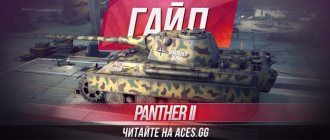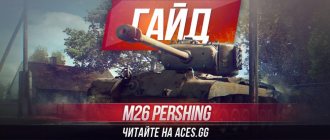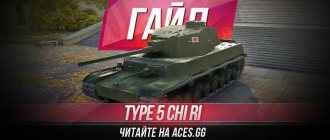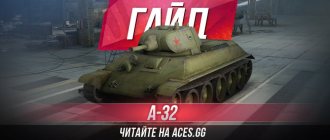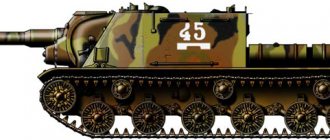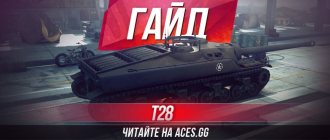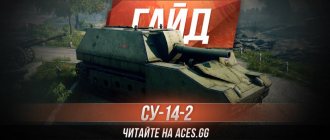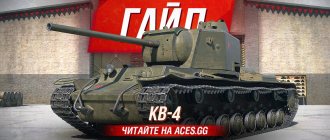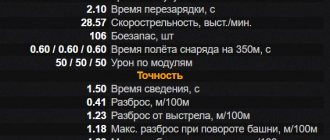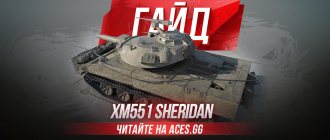TTX Centurion Mk. I
Without further ado, let's move straight to analyzing the parameters of our Briton and the first thing that catches your eye is its excellent basic visibility of 400 meters, while our safety margin is typical by the standards of our classmates.
As for survivability, in the distant patch 0.9.0 our tank received an HD model, from that moment on the Centurion Mk. I reservation characteristics have become much worse. Be prepared for the fact that all guns with a penetration of more than 150 millimeters will pierce the forehead of our hull. We have a screen along the side, but it doesn’t help much; as you can see, there is very little armor here.
Our turret is stronger, it is often capable of receiving non-penetrations and ricochets from tanks of levels 7-8 (although there are sad exceptions here), but everything higher can penetrate the Centurion Mk. 1 World of Tanks into the front of the tower without any difficulty.
I would also like to note that when our vehicle is hit head-on, the ammunition rack is very often criticized, this greatly ruins our life.
Now I would like to say that this unit has very large dimensions for a medium tank and also weighs quite a lot, so get used to the fact that the Centurion Mk. I WoT has mediocre top speed, dynamics and agility. Without remorse, our Briton can be called slow.
Centurion Mk. 7/1
British medium tank of the ninth level. It has good dynamics, an excellent weapon with a large vertical aiming angle. At the same time, it has a low maximum speed and insufficient armor, which, given the large dimensions of the vehicle, makes it an easy target.
The last tank before the future premium medium tank FV4202.
Quote from wiki:
Combat effectiveness
Centurion Mk. 7/1 is one of the best support tanks. Its accurate weapon with high penetrating power and high one-time damage allows you to easily destroy most opponents, including level 10. The tank can successfully fire at any distance. An important feature of the gun: HESH shells (HE shells with increased armor penetration) are available for it as premium shells.
The frontal armor of the tank is quite thick, but due to insufficient slopes of the armor plates and a large number of vulnerable spots, it can be penetrated very easily. Most tier 10 guns will penetrate Centurion Mk. 7/1 even with a mask. However, excellent visibility and excellent vertical aiming angles allow you to keep the enemy at a distance and fire at medium and long distances.
One of the main disadvantages of the car is its low maximum speed, which is compensated by its high cross-country ability and fast acceleration. Playing alone on this tank is quite difficult, so you should coordinate your actions with your allies and not rush forward.
Advantages:
- an accurate weapon with high damage and armor penetration;
- good maneuverability;
- excellent vertical aiming angles;
- screen armor on the sides;
- great review.
Flaws:
- mediocre booking;
- vulnerable location of the ammunition rack in the forehead;
- low rate of fire;
- low maximum speed;
- large dimensions;
- hESH shells for the top gun.
Camouflage coefficient - 12/8.7/2.7.
UVN: -10 ... +18.
Overview stock tower 400 meters, top tower 410 meters.
As stock, the tank has a cannon from its predecessor, the Centurion Mk. I, which this tank handled quite comfortably at both lvl 9 and 10. Although in some cases gold was required. Those. Bringing a tank to the top won't be excruciatingly painful.
During the passage, the first thing I did was study the chassis for free experience - the cost is 23,000 experience. You can not waste the free space, but then you will need to install reinforced springs, which will take up a useful slot.
The radio comes from its predecessor.
Next, we study the pre-top gun, which differs from the stock one only in its slightly higher rate of fire and accuracy - the cost is 45,000 experience.
Then the top tower, which adds a margin of safety and increases visibility by 10 meters - costs 24,000 experience, can be studied for free.
But then I would like to hear advice on what to study: engine + 200 hp, or top gun?
The engine costs 45,000 experience, the top gun costs 55,000 experience. At first I planned to study the engine earlier in order to improve the dynamics, after all, this is an ST, but I read the reviews on the OF, and with a top engine the dynamics do not increase much. Modified on August 25, 2015 by Bizon_751824
gun
Now let's talk about much more pleasant things, because weapons in our case are really worthy of respect, although there will also be some disadvantages.
So, Centurion Mk. 1 gun has excellent penetration parameters with a basic shell, the best among the ST-8. This practically saves us from the need to carry gold, although for unforeseen situations it would not be superfluous to buy 10-15 shells, the ammunition here is huge.
At the same time, we were given a small alphastrike, but thanks to the good rate of fire of the Centurion Mk. I tank can deal about 1725 pure damage per minute, which is quite good.
Another positive feature in our case will be comfortable vertical aiming angles; the gun goes down by 10 degrees, making it convenient to play off the terrain.
And now the promised shortcomings - the British medium tank Centurion Mk. I World of Tanks received a small spread, but the stabilization here is poor and the gun takes a long time to bring down, something definitely needs to be done about this.
The history of the Australian Centurion tank: survived a nuclear test and fought in Vietnam
The fate of certain types of military equipment, like the fate of people, is often unpredictable. Someone dies in the first battle, someone pulls the burden of routine service in a remote garrison and retires after long service. But some experience trials and adventures that are more than enough for ten. Thus, other examples of military equipment, despite numerous vicissitudes of fortune, survive in the most difficult conditions and ultimately become monuments of their era. An example of this is the Australian Centurion Mk.3 tank, which was scorched by a nuclear explosion and took part in combat operations in Southeast Asia.
The history of the creation of the Centurion Mk.3 tank
After heavy German tanks appeared on the battlefield in the second half of World War II, work began in Great Britain to create armored vehicles capable of withstanding them on equal terms.
Within the framework of the “universal tank” concept, which in the future was intended to replace the infantry and cruiser tanks in service, the A41 project was created. This car was later sometimes called the British "Tiger". However, comparison with the German heavy tank Pz.Kpfw. Tiger Ausf. H1 is not entirely correct. The Tiger, weighing 57 tons, was about 9 tons heavier than the first modification of the Centurion. At the same time, the mobility and range of the German and English tanks turned out to be very close. In terms of protection in the frontal projection, the British and German tanks were approximately equivalent, but the Centurion’s 51 mm thick side armor, even taking into account the 6 mm anti-cumulative shields, turned out to be thinner than that of the Tiger, covered with 80 mm side armor. Nevertheless, the Centurion was a very successful combat vehicle for its time, with high modernization potential. Serial production of new tanks was carried out at Leyland Motors, Royal Ordnance Factory and Vickers. In the final days of World War II, six prototypes rolled off the factory's assembly line, but by the time they arrived in Germany, the war had already ended. Subsequently, during combat operations in Korea, India, Vietnam, the Middle East and Angola, the Centurion proved to be one of the best tanks of the post-war period. In total, more than 4,400 Centurion tanks of various modifications were built before 1962.
The first production modification of the Centurion Mk.1 was armed with a 76-mm gun, based on the QF 17 pounder towed anti-tank gun. At a distance of up to 900 m, the gun could successfully fight most German tanks, but the effect of the high-explosive fragmentation projectile was weak. As an additional weapon, a 20-mm Polsten cannon was installed in the turret; on the Centurion Mk.2 modification it was replaced with a BESA rifle-caliber machine gun. On Centurion tanks, starting with this variant, six 51-mm grenade launchers were installed in the front of the turret for firing smoke grenades. All cars of the Mk.2 modification were upgraded to the Mk.Z level in the early 1950s.
Centurion Mk. 2
In 1947, the main modification was adopted - the Centurion Mk.3 with a 20-pound QF 20 pounder gun of 83.8 mm caliber. At a distance of 914 m, an armor-piercing projectile with an initial speed of 1020 m/s could penetrate homogeneous armor along the normal 210 mm. The armor penetration of a sub-caliber projectile with an initial speed of 1465 m/s at the same range reached 300 mm. Subsequently, later modifications were armed with a 107 mm rifled semi-automatic L7 gun, which was better suited to combat Soviet T-54/55/62 tanks.
The Centurion Mk.3 tank received a weapon stabilizer in the vertical and horizontal guidance planes. The creation of a serial two-plane, reliably operating stabilizer, the Metrovick FVGCE Mk.1, was a great success for the British, significantly increasing the tank’s effectiveness on the battlefield. The presence of a two-plane stabilization system significantly increased the likelihood of hitting an enemy tank. At a speed of 10-15 km/h, the firing efficiency differed slightly from the probability of a hit when firing from a standstill. In addition, the stabilizer not only increases the accuracy of shooting while moving, but also the average speed of the tank on the battlefield, thereby reducing its vulnerability.
Centurion Mk.3
The Centurion Mk.3 tank was equipped with a Rolls-Royce Meteor liquid-cooled 12-cylinder V-shaped engine with a power of 650 hp. and Merritt-Brown transmission. The power unit was a further development of the engine and transmission of the Cromwell and Comet I tanks.
Participation of the Centurion Mk.3 Type K tank in a nuclear test at the Emu Field test site
In the early 1950s, Australia, as Britain's closest ally, began receiving Centurion Mk.3 tanks, which were very modern at that time.
In total, the Australian Army ordered 143 Centurions. Among the vehicles sent by sea was a tank with serial number 39\190, assembled at the Royal Ordnance Factory in 1951. In the Australian Armed Forces, the armored vehicle was assigned the number 169041 and was used at a tank training ground for training purposes. Subsequently, it was decided to use this tank in a nuclear test known as “Operation Totem-1”. In the early 1950s, Great Britain entered the “nuclear race,” but since nuclear testing required a test site that met safety requirements, the British agreed on the allocation of sites with the government of the “Green Continent.” A vast area in the southern part of Australia, 450 km north of Adelaide, was designated as a nuclear test site. This area was chosen due to its very sparse population. The desert area was not used in any way for economic activity, but the nomadic routes of the local aborigines passed here. The Totem testing site was identified as an area in the Victoria Desert known as Emu Field. In 1952, a 2 km long runway and a residential village were built here on the site of a dry lake. Since the British were in a hurry to build up and improve their nuclear potential in terms of reliability and efficiency, work proceeded at a high pace.
An implosion-type nuclear explosive device based on Plutonium-240 was tested as part of the creation of the British Blue Danube atomic bomb. The nuclear charge was placed on top of a 31 m high steel tower. Various measuring instruments were placed around the tower, but unlike the first American and Soviet atmospheric nuclear test explosions, no buildings or fortifications were erected. In order to assess the impact of the damaging factors of nuclear weapons, separate samples of weapons and military equipment were delivered to the test site, among which was a tank taken from the Australian army's Centurion Mk.3 Type K.
Delivery of the armored vehicle to the training ground was carried out with great difficulties. Due to the remote location and lack of a good road, the trailer carrying the tank got stuck in the sand. The Centurion traveled the last part of the journey to the testing site under its own power. At that time, the car's odometer showed only 740 kilometers.
Before the nuclear explosion, full ammunition was loaded into it, fuel tanks were filled and tank mannequins were placed. According to the exercise scenario, a vehicle with a running engine was placed at a distance of 460 meters from a tower with a nuclear charge.
Cloud formed after the Totem-1 nuclear test
An explosion with an energy release of about 10 kt scorched the desert on October 15, 1953 at 07.00 local time. The mushroom cloud that formed after the explosion rose to a height of about 5000 m and, due to the lack of wind, dissipated very slowly. This led to the fact that a significant part of the radioactive dust raised by the explosion fell in the vicinity of the test site. The Totem-1 nuclear test, despite its relatively low power, turned out to be very dirty. Areas up to 180 km from the epicenter were heavily radioactively contaminated. The so-called “black fog” reached Welborn Hill, where Australian Aborigines suffered from it.
Despite the relative proximity to the explosion point, the tank was not destroyed, although it was damaged. The shock wave moved it 1.5 m and turned it around. Since the hatches were not locked from the inside, they were opened by the force of the explosion, resulting in damage to some internal parts and mannequins. Under the influence of light radiation and a shock wave carrying tons of sand abrasive, the glasses of optical instruments became cloudy. The canvas casing of the gun mantlet was burned, and the side screens were torn off and thrown 180 meters. The roof of the engine compartment was also damaged. However, upon examination of the tank, it turned out that the engine was not seriously damaged. Despite the extreme pressure drops and the impact of the electromagnetic pulse, the engine continued to work, and stalled only after the fuel in the tanks ran out.
Evacuation from a nuclear test site, decontamination, repair and modernization of the “atomic tank”
Three days after the nuclear test, the crew, having carried out the minimum necessary repair work, took their places in the tank and left the test site under their own power. However, it was not possible to go far; the engine, clogged with sand, soon jammed and the Centurion was evacuated on a trailer, which was towed by two tractors.
At the same time, none of those involved in the evacuation of the tank used protective equipment, although inscriptions about the dangers of radiation were placed on the tower. Subsequently, 12 of the 16 servicemen who worked on board 169041 died from cancer.
After the tank was delivered to the Woomera training ground, it was decontaminated and placed in a storage area. In 1956, the induced radiation in the armor weakened to a safe level and after a radiation survey, the Centurion was sent to the Pukapunyal tank range, located in southeastern Australia, 10 km west of the city of Seymour. The failed engine was replaced, and the turret with its cloudy observation devices and faulty sight was dismantled. In this form, the “atomic tank” was used as a tractor, and two years later it was sent for major repairs. During repairs and modernization, the tank was brought to the level of the Centurion Mk.5/1, armed with a 105 mm L7 gun. With such a gun, the Centurion could fight all types of tanks then available in the Soviet Army. From 1959 to 1962, tank number 169041 was in “storage”, after which it was transferred to the training center of the 1st Armored Regiment.
Participation of the “atomic tank” in the Vietnam War
In 1962, the Australian leadership decided to support the US fight against the advance of communist forces in Southeast Asia.
Initially, a small group of advisers was sent to Saigon, but as the conflict escalated, transport and combat aircraft, armored vehicles and regular ground units were sent to South Vietnam. Destroyers of the Royal Australian Navy were involved in American patrols of the coast of North Vietnam. The number of Australians at the peak of the conflict in the late 1960s reached 7,672. 9 infantry battalions took part in combat operations until 1971. In total, more than 50,000 Australian troops passed through the Vietnam War, of whom 494 were killed, 2,368 were wounded, and two were missing in action. To support Australian infantry fighting in the jungle, tanks from the 1st Armored Regiment were sent in 1968. Among the armored tracked vehicles delivered by sea to South Vietnam was the hero of our story. The tank was given the tactical number 24C and entered into combat service in September. In the tank platoon where the Centurion was used as a command vehicle, it was known among other crews as "Sweet Fanny".
The Centurion crew periodically participated in combat operations without incident, until on May 7, 1969, during the battle, the tank was hit by a cumulative grenade (most likely fired from an RPG-2). The shell pierced the armor in the lower left part of the fighting compartment. The cumulative jet passed diagonally, severely wounding the gunner. After evacuating a wounded colleague, other crew members took up defensive positions in the tank. Although the armor was pierced, the explosion did not damage vital components, and the tank retained its combat capability. By that time, the Centurion had a mileage of more than 4,000 km, was in need of repairs, and they decided to send it back to Australia. In January 1970, tank No. 169041, along with two other faulty armored vehicles, was sent to the South Vietnamese port of Vung Tau for loading onto a ship bound for Melbourne.
Service of the “atomic tank” after returning from Southeast Asia
After arriving in Australia, in May 1970, the damaged vehicle was taken to a tank repair facility in Bandiana. During the next major overhaul, the tank was equipped with an improved optical rangefinder and an IR spotlight designed to ensure the operation of night vision devices.
The overhaul and modernization work was completed at the end of 1970 and after several years in storage, the Centurion was transferred to the 1st Armored Regiment. This time the tank was given the tactical number 11A and the unofficial name “Angelika”. Its active service continued until the end of 1976, when the 1st Armored Regiment was re-equipped with Leopard AS1 (1A4) tanks.
The decision to purchase West German Leopards, intended to replace the Centurions, was made on a competitive basis, after comparative tests of the Leopard-1A4 and the American M60A1 in the summer of 1972 at the Queensland tropical training ground. A contract with Germany for the supply of 90 battle tanks, 6 armored recovery vehicles and 5 bridge layers was concluded in 1974.
Although the Centurion, having been through a nuclear test site and the Vietnam War, was put into storage in the first half of 1977, it was returned to the 1st Armored Regiment a few years later.
"Centurion" No. 169041 at the farewell parade in 1992
The vehicle, brought into perfect condition by the regiment's repair service, was used during various special events. The last time tank No. 169041 participated in the farewell parade of Chief of the General Staff H.J. Coates in April 1992. In November 1992, the "nuclear tank" was erected as a monument at the Robertson Barracks military base, approximately 15 kilometers east of Darwin city centre.
It is currently the main Australian Army base in Australia's Northern Territory and was the headquarters of the 1st Armored Regiment until 2013.
In total, the tank served for 23 years, including 15 months in South Vietnam. In 2022, a commemorative plaque with the main milestones of his biography was attached to the armor of the “atomic tank”.
In addition to tank No. 169041, two more Australian Centurions took part in tests known as “Operation Buffalo” at the nuclear test site in the vicinity of Maralinga, but this vehicle was the only one put into operation after direct exposure to the damaging factors of a nuclear explosion.
Advantages and disadvantages
We have covered everything you need to know about the tank for its proper use in battle, but to make it easier for you to navigate, let’s look at the most important strengths and weaknesses separately. Pros: • Quite strong forehead of the tower; • Comfortable vertical aiming angles; • Excellent overview; • Good rate of fire; • Best armor penetration at the level. Cons: • Weak armor in general; • Poor mobility; • Barn dimensions; • Small alphastrike; • Mediocre accuracy; • Frequent ammo crits.
Equipment for Centurion Mk. I
To increase the comfort of the game, you need to choose the right additional modules, because they can greatly enhance the existing advantages, as well as brighten up the disadvantages. In the case of the Centurion Mk. 1 equipment is equipped with the following: 1. - this module is always held in high esteem, because it allows us to make our damage per minute even more dangerous. 2. - due to the fact that we have problems with accuracy and stabilization, this option is required. 3. - will give an increase in DPM, improve visibility, speed up convergence, there is everything you need for bending.
As an alternative to the last point, you can put this if you have not yet upgraded your review perks. And if you are tired of crits or even explosions of ammunition, you can even put , although this option is completely a backup.
Legendary camouflage "Dingo"
Some time after the first battle on the Centurion Mk. 5/1 you may receive a personal offer with the legendary “Dingo” camouflage. This war paint will highlight the wild nature of your tank and give it the combat name “Centurion Mk. 5/1 Dingo.”
